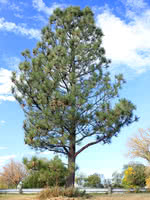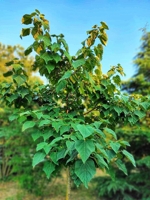Mon-Fri 9am - 5pm Mountain time
Ponderosa Pine vs Empress Tree
Pinus ponderosa
Paulownia tomentosa
Ponderosa Pine is the tallest known pine in North America. This popular evergreen has distinctive, textured bark and long needles.
This makes it an excellent ornamental tree for landscaping on large properties. Ponderosa Pine is hardy in a variety of soil conditions.
The Empress Tree is a fast growing, ornamental shade tree. It has purple, fragrant flowers that are quite attractive. The flowers emerge before the leaves in early spring. The leaves of this tree can grow very large, up to 30 cm long.
As one of the fastest growing trees in the world, this tree has been given considerable attention for carbon sequestration projects. It drops many seeds which can make it invasive in warmer climates. Please do some research and plant the right tree in the right place.
The Empress tree’s genus name comes from Princess Paulowna, daughter of Tsar Paul I of Russia.

